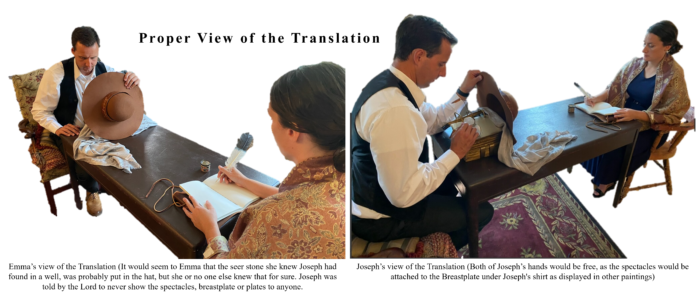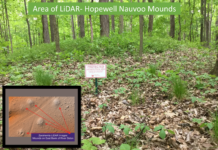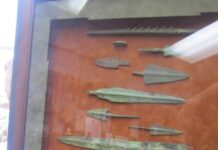Questions about the Facts of Translation
-Did Joseph Smith have a stone or two he had found? Yes,
-Did Joseph Smith have a hat? Yes! More like a farmers hat rather than a stove pope hat I would think, but maybe he had both types.
-Did anyone see those items at various times? Yes! David, Martin, and Emma and many others.
-Did any of those 3 mentioned above, see words appear on a stone while the stone was in Joseph’s hat? No! If you say yes, ask yourself this question. Why would Joseph let other non scribes see the sacred words at any time?
-If you say there were words on a stone, who wrote those words on the stone? God? Nephi? An angel?
-Why would Nephi and Mormon write words in reformed Egyptian on the plates, if they thought Joseph would just get those words in English later?
How could Emma, Martin and David say they were witnesses to the exact method of translation? They Can’t! Below is what I believe they would have seen!
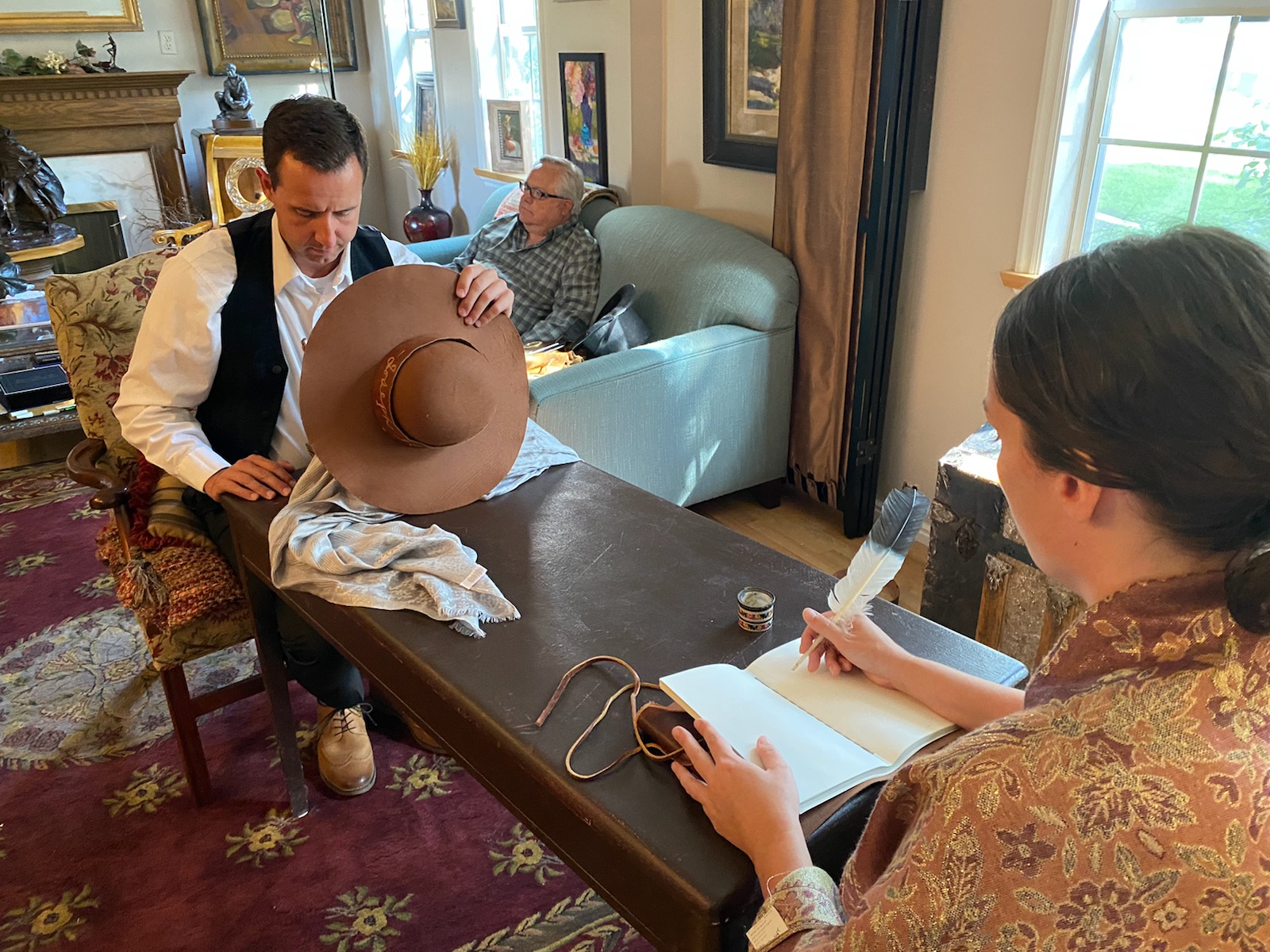 As you see above, the scribe like Emma, may have known Joseph had a stone, and they could see in this picture that he has a hat, but they most likely didn’t know what was in the hat, correct? No where does it say by any scribe, “I literally saw Joseph put a stone in his hat”, or “I saw the words on the stone in his hat.” Here Emma can’t even see the gold plates as they were partially covered with a linen. Joseph had the breastplate on under his shirt* and the spectacles were attached to the breastplate, with the hat blocking out the view of the spectacles.
As you see above, the scribe like Emma, may have known Joseph had a stone, and they could see in this picture that he has a hat, but they most likely didn’t know what was in the hat, correct? No where does it say by any scribe, “I literally saw Joseph put a stone in his hat”, or “I saw the words on the stone in his hat.” Here Emma can’t even see the gold plates as they were partially covered with a linen. Joseph had the breastplate on under his shirt* and the spectacles were attached to the breastplate, with the hat blocking out the view of the spectacles.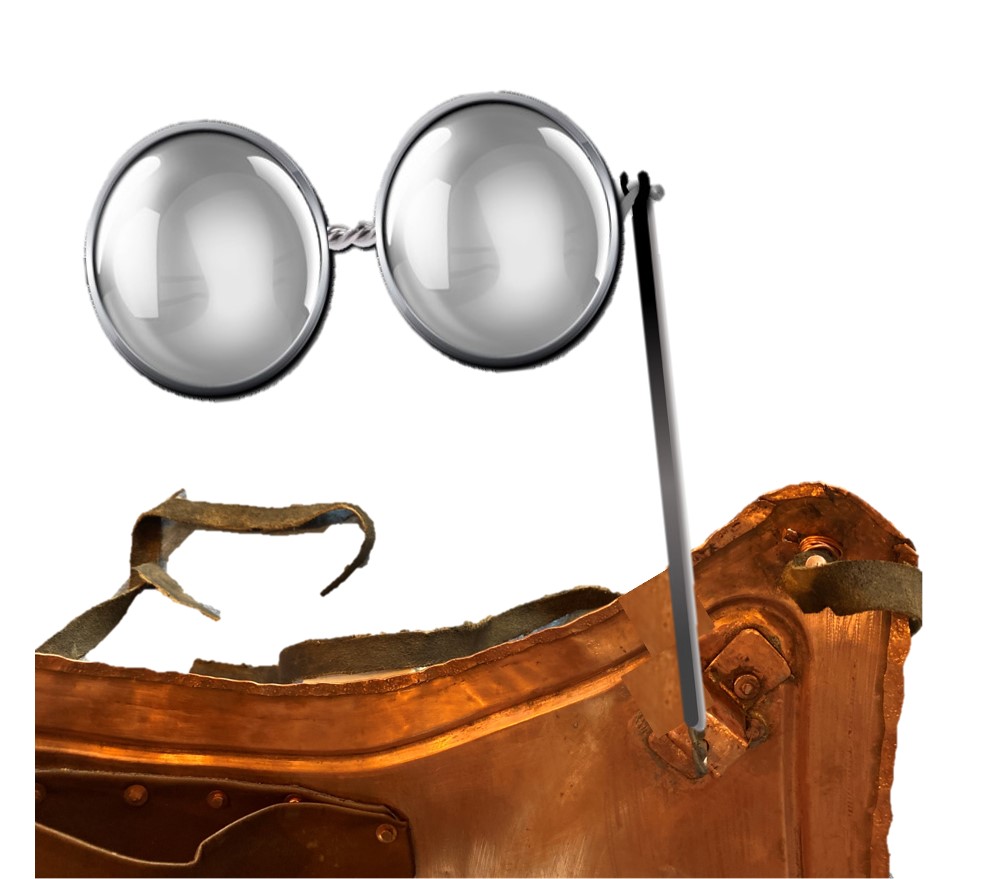
*“That of which I spoke, which Joseph termed a key, was indeed nothing more nor less than a Urim and Thummim by which the angel manifested those things to him that were shown him in, vision; by which also he could at any time ascertain the approach of danger, either to himself or the record, and for this cause he kept these things constantly about his person.” Lucy Mack Smith Journal
I believe the “Key”(Spectacles only) was needed to “activate” or “plug in”, giving the ability of the breastplate and spectacles to become operable for the Lord to communicate with Jospeh.
The Lord’s Instrument
President Kimball said, ““We are awed by the perspicacity and discernment of the scientists, whose accumulated knowledge is great, but there is still greater knowledge; there are more perfect instruments; there is much more to learn. Most of us can but imagine how the great truths have been transmitted through the ages. Exactly how this precious instrument, the Urim and Thummim, operates we can only surmise, but it seems to be infinitely superior to any mechanism ever dreamed of yet by researchers. It would seem to be a receiving set, or instrument. For a set to receive pictures and programs, there must be a broadcasting set. The scripture above quoted indicates that the abode of God is a master Urim and Thummim, and the synchronization of transmitting and receiving apparatus of this kind can have no limitation… Is it difficult to believe that the Urim and Thummim could be such a precision instrument to transmit messages from God to his supreme creation — man? (Spencer W. Kimball, Faith Precedes the Miracle, Pg.52 – Pg.53)
Another question. Why doesn’t Emma, David, Martin or any other witness ever mention what Joseph did with the breastplate? No one even mentions that Joseph used a breastplate, yet we know it was found with the gold plates. I don’t believe the breastplate was just an ornament for design or jus looking at. I feel it was essential to the translation.
Head (Spectacles) and Heart (Breastplate)
Truly rock-ribbed faith and uncompromised conviction comes with its most complete power when it engages our head as well as our heart… “Two manifestations, two witnesses if you will—the force of fact as well as the force of feeling.” Jeffery R. Holland 2017
Just as Elder Holland said, there needs to be both heart and head in the correct translation method. Joseph’s mind (Spectacles) and his heart (Breastplate) would connect just as the instruments did. I believe the powerful words of Lucy Mack Smith who said, “these things, (meaning the spectacles and the breastplate) “remained constantly on his person.“ Indeed they did! It appears to me the instruments must be attached or connected to draw in the powers of Heaven and Earth.
Sometimes it may have looked like Joseph had his head slightly in his hat, but in reality he was probably looking closer at the spectacles that were attached to the breastplate. The purpose of the hat was not to block out light so Joseph could see better, but to hide the spectacles from the view of whomever was the scribe. Below is another view of the correct translation process. Joseph did not use a curtain as you can see the quotes below:

A Curtain? No! Elder Neal A. Maxwell said,
“He [Joseph] said there was a book deposited, written upon gold plates, giving an account of the former inhabitants of this continent, and the source from whence they sprang. He also said that the fulness of the everlasting Gospel was contained in it, as delivered by the Savior to the ancient inhabitants; Also, that there were two stones in silver bows—and these stones, fastened to a breastplate, constituted what is called the Urim and Thummim—deposited with the plates; and the possession and use of these stones were what constituted “seers” in ancient or former times; and that God had prepared them for the purpose of translating the book.” JSH 1:34-35
“In fact, Elizabeth Anne Whitmer Cowdery, Oliver’s wife, said, “Joseph never had a curtain drawn between him and his scribe” (quoted in John W. Welch and Tim Rathbone, “The Translation of the Book of Mormon: Basic Historical Information,” F.A.R.M.S.). Emma likewise said of her days as scribe, early on, that Joseph dictated “hour after hour with nothing between us” (“Last Testimony of Sister Emma,”). “Of course, the real revelatory process involved Joseph’s mind and faith, which could not be seen by others in any case…” By Elder Neal A. Maxwell “By the Gift and Power of God”
Answers is are Always in the Scriptures
There is not even one scriptural account that says anything about a stone in a hat as the method of translation. That tells me I can’t completely believe the words of Martin Harris, David Whitmer, Emma Smith in 1879, William McLellin or anyone else.
They may have misstated, embellished, or heard from someone else, as they cannot give any firsthand evidence they ever saw words on the seer stone in a hat, during the translation process. PERIOD.
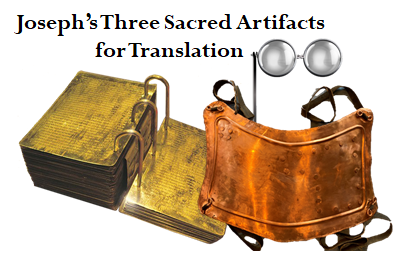 I trust Oliver Cowdery and Joseph Smith who are the only firsthand witnesses that saw the actual translation instruments. What are the instruments found with the plates in the stone box at Cumorah? (Picture Left) No single stone, or a hat was buried with the plates. Why would the Lord have the Brother of Jared and Moroni bury the proper instruments for translation, only to have Joseph use a silly stone he had found in a well? (Ether 3:22-24)
I trust Oliver Cowdery and Joseph Smith who are the only firsthand witnesses that saw the actual translation instruments. What are the instruments found with the plates in the stone box at Cumorah? (Picture Left) No single stone, or a hat was buried with the plates. Why would the Lord have the Brother of Jared and Moroni bury the proper instruments for translation, only to have Joseph use a silly stone he had found in a well? (Ether 3:22-24)
Which is correct?
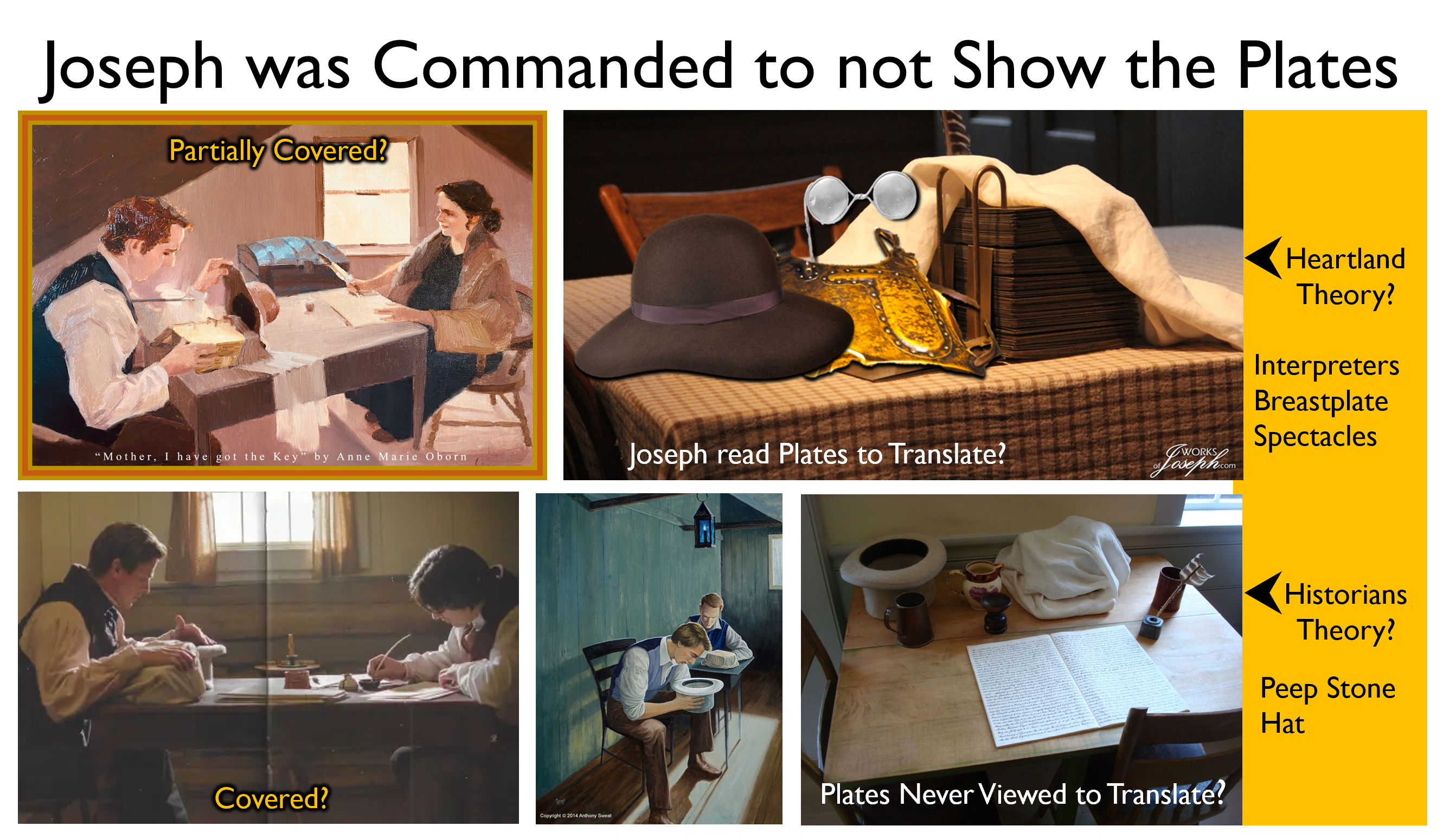
Most of those who believe Joseph used a stone in a hat, also believe Joseph did not look at the actual plates as they were not needed, since the words were written on the stone. I ask you then. Why would Nephi, Mormon and other prophets write on the plates and work so hard at protecting the plates from the Lamanites, if they would not be needed by Joseph to translate at a latter time? Joseph not looking at the plates is silly!
Oliver’s vision wouldn’t need the be blocked with the hat like Emma, as he is quoted that he saw the plates, the spectacles, and the breastplate.
“Cowdery was requested to state how the plates were found, which he did. He stated that Smith looked onto or through the transparent stones to translate what was on the plates. [So, apparently Cowdery saw the plates and spectacles but did now see what was written in the spectacles]. Continued, “I then asked him if he had ever looked through the stones to see what he could see in them; his reply was that he was not permitted to look into them. I asked him who debarred him from looking into them; he remained sometime in silence, then said that he had so much confidence in his friend Smith, who told him that he must not look into them, that he did not presume to do so lest he should tempt God and be struck dead” (Allen, “Historian’s Corner,” 308). As told in: The Process of Translating the Book of Mormon Joseph Fielding McConkie (Professor of Ancient Scripture, BYU) Craig J. Ostler (Assistant Professor of Church History and Doctrine, BYU)
“When Brother Samuel W. Richards was eighty-two, (1906) he dictated a statement reporting Oliver Cowdery’s recollections of Book of Mormon translation: “He represented Joseph as sitting at a table with the plates before him, translating them by means of the Urim and Thummim, while he (Oliver) sat beside him writing every word as Joseph spoke them to him. This was done by holding the ‘translators’ over the hieroglyphics, the translation appearing distinctly on the instrument, which had been touched by the finger of God and dedicated and consecrated for the express purpose of translating languages. Every word was distinctly visible even to every letter; and if Oliver omitted a word or failed to spell a word correctly, the translation remained on the ‘interpreter’ until it was copied correctly.” Richard Lloyd Anderson Ensign/1977

THE 2 QUOTES THAT SHOULD STAND ALONE
-1- “In the Wentworth Letter, the Prophet wrote: “With the records was found a curious instrument, which the ancients called “Urim and Thummim,” which consisted of two transparent stones set in the rim of a bow fastened to a breast plate. Through the medium of the Urim and Thummim I translated the record by the gift and power of God” (History of the Church, 4:537).
-2- In the October 1834 Messenger and Advocate [the Church newspaper in Kirtland, Ohio], Oliver Cowdery wrote: “These were days never to be forgotten to sit under the sound of a voice dictated by the inspiration of heaven, awakened the utmost gratitude of this bosom! Day after day I continued, uninterrupted, to write from his mouth, as he translated, with the Urim and Thummim, or, as the Nephites would have said, ‘Interpreters,’ the history or record called ‘The Book of Mormon’” (Messenger and Advocate, 1:14; Also known as Letter I Oliver Cowdery to William W. Phelps, 7 September 1834).
Here is more Scriptural Evidence that Joseph used the Interpreters or Urim and Thummim or Spectacles. Not a Stone in a Hat! See JSH 1:35,52,62,75*; Mosiah 28:13, 20; Ether 3:22-23; 4:5; Alma 37:21, 24-25
When Cowdery returned to Church membership in 1848 he spoke to an Iowa conference. His words there were recorded by Reuben Miller: “I wrote with my own pen the entire Book of Mormon (save a few pages) as it fell from the lips of the Prophet as he translated it by the gift and power of God by means of the Urim and Thummim, or as it is called by that book, holy interpreters. I beheld with my eyes and handled with my hands the gold plates from which it was translated. I also beheld the Interpreters. That book is true. … I wrote it myself as it fell from the lips of the Prophet.”
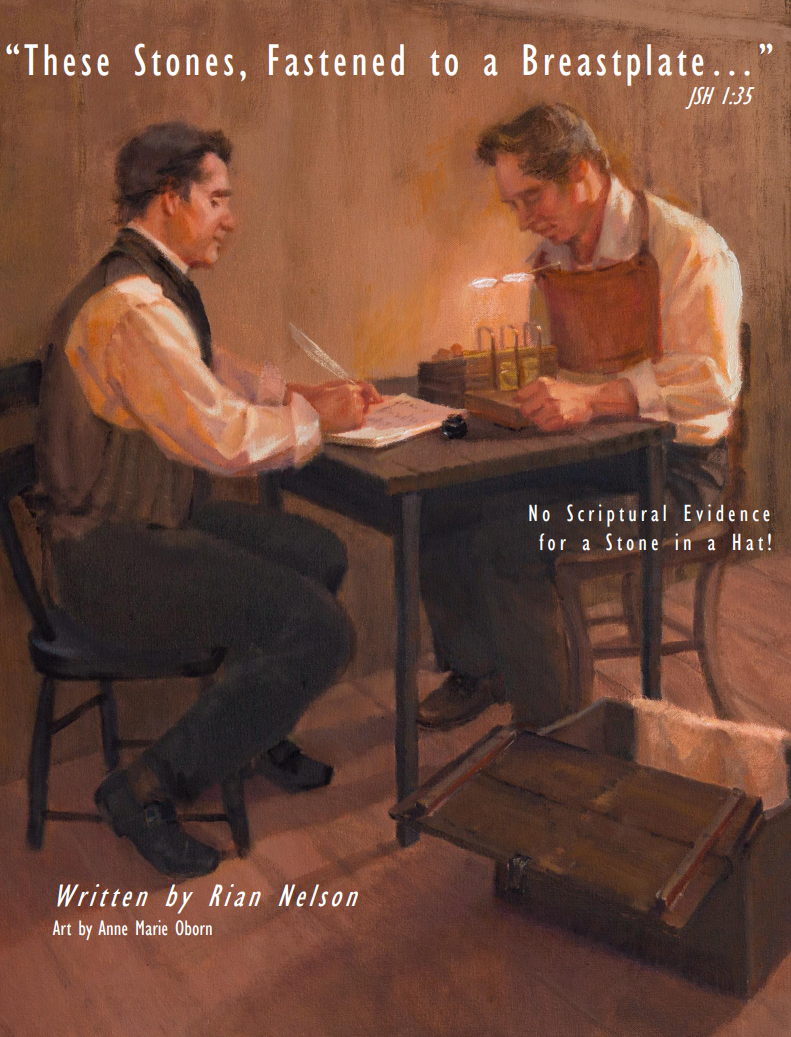
The Miller journal can be tested by comparing it with official records of the Cowdery speeches, and it is clearly accurate. Thus the above words are likely to be Cowdery verbatim. This judgment is essential because in the report Oliver Cowdery says, “I … handled with my hands the gold plates.” Yet another Witness, David Whitmer, insisted that he had never handled the plates; he only watched as the angel in the vision displayed the plates and other sacred objects. Since Whitmer and Cowdery were together at this impressive vision, one must infer that Cowdery did not handle the plates at that time. Thus a distinction emerges between the key secretary and his witness brother-in-law: at some time during the translation process Oliver Cowdery evidently handled the plates. “By the Gift and Power of God” By Richard Lloyd Anderson
“I wish Messrs. Whitmer and Harris, and those who have worked out theories based upon their statements, had left the whole matter where the Prophet Joseph left it; but this they failed to do.” (Defense of The Faith and The Saints, Volume 1; p. 286)
“They say the Nephite characters, to be translated, appeared in Urim and Thummim. We say that may be true, or the Prophet may have looked through the interpreters—since they were transparent stones—and thus have seen the characters. They say the interpretation appeared in English, under the Nephite characters in Urim and Thummim; we say, if so, then that interpretation, after being wrought out in the Prophet’s mind (See D&C 9:7-9), was reflected into Urim and Thummim and held visible there until written.
The English interpretation was a reflex from the Prophet’s mind. (And may it not be that the peculiar quality of the Urim and Thummim was to reflect thought, especially God-given or inspired thought, as other substances reflect objects?) All this is possible, and is not in conflict with what either the Prophet or Oliver Cowdery said upon the subject; nor in conflict with the Lord’s description of translation. But to insist that the translation of the Book of Mormon was an arbitrary piece of mechanical work, wrought out by transparent stones rather than in the inspired mind of the Prophet, is in conflict with the Lord’s description of translation, and all the reasonable conclusions that may be drawn from the known facts in the case.” (BH Roberts Defense of The Faith and The Saints, Volume 1; p. 285

